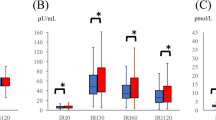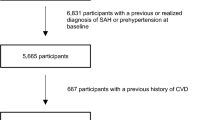Abstract
Objectives: To evaluate peripheral insulin stimulated glucose uptake as a predictor for increase in blood pressure in hypertension-prone men.
Design: A follow-up study 5 years after a primary investigation that included an euglycaemic hyperinsulinaemic clamp to evaluate insulin sensitivity.
Subjects: Thirty-two men with a family history of hypertension (relatives) and 22 men with no hypertension in the family (controls). All were normotensive and had a normal glucose tolerance.
Main outcome measures: Change in blood pressure over 5 years and its relation to the values obtained in the basal investigation.
Results: Systolic and diastolic blood pressure increased in both groups during the 5 years, but diastolic blood pressure increased more in relatives than in controls (11 mm Hg vs 5 mm Hg, P = 0.03). The change in diastolic blood pressure was correlated to basal BMI (r = 0.43, P = 0.02) only in controls. There were no correlations between the change in blood pressure during the 5 years and basal glucose disposal nor to any of the other basal parameters in either relatives or controls.
Conclusions: Insulin sensitivity did not predict the change in blood pressure during the 5 years either in hypertension-prone men or in controls, nor did anthropometrical measurements, basal and stimulated insulin and maximal oxygen uptake. The blood pressure increase was related to basal BMI only in controls.
This is a preview of subscription content, access via your institution
Access options
Subscribe to this journal
Receive 12 digital issues and online access to articles
$119.00 per year
only $9.92 per issue
Buy this article
- Purchase on Springer Link
- Instant access to full article PDF
Prices may be subject to local taxes which are calculated during checkout
Similar content being viewed by others
References
Reaven GM, Lithell H, Landsberg L Hypertension and associated metabolic abnormalities – the role of insulin resistance and the sympathoadrenal system N Engl J Med 1996 334 374–381
Lind L, Berne C, Lithell H Prevalence of insulin resistance in essential hypertension J Hypertens 1995 13 1457–1462
Endre T et alInsulin resistance is coupled to low physical fitness in normotensive men with a family history of hypertension J Hypertens 1994 12 81–88
Ferrari P et alAltered insulin sensitivity, hyperinsulinemia, and dyslipedemia in individuals with a hypertensive parent Am J Med 1991 91 589–596
Beatty OL et alInsulin resistance in offspring of hypertensive parents Br Med J 1993 307 92–96
Misra A et alHyperinsulinemia and dyslipidemia in non-obese, normotensive offspring of hypertensive parents in northern India Blood Press 1998 7 286–290
Facchini F et alInsulin resistance, hyperinsulinemia, and dyslipidemia in nonobese individuals with a family history of hypertension Am J Hypertens 1992 5 694–699
Eriksson KF, Lindgärde F Impaired glucose tolerance in a middle-aged male urban population: a new approach for identifying high-risk cases Diabetologia 1990 33 526–531
Diabetes mellitus. Report of a WHO study group. 1985; WHO Tech Rep Ser No 727
Åstrand I Aerobic work capacity in men and women with special reference to age Acta Physiol Scand 1960 169 (suppl) 49–92
De Fronzo RA, Tobin JD, Andres R Glucose clamp technique: a method for quantifying insulin secretion and resistance Am J Physiol 1979 237 E214–E233
Endre T, Mattiasson I, Berglund G, Hulthén UL Insulin and renal sodium retention in hypertension-prone men Hypertension 1994 23 313–319
Ogihara T et alA non-chromatographic non-extraction radioimmunoassay for serum aldosterone J Clin Endocrinol Metab 1985 45 726–731
Yip J, Facchini FS, Reaven GM Resistance to insulin-mediated glucose disposal as a predictor of cardiovascular disease J Clin Endocrinol Metabol 1998 83 2773–2776
Nesbitt SD et alHome blood pressure as a predictor of future blood pressure stability in borderline hypertension. The Tecumseh study Am J Hypertens 1997 10 1270–1280
Haffner SM, Ferrannini E, Hazuda HP, Stern MP Clustering of cardiovascular risk factors in confirmedprehypertensive individuals Hypertension 1992 20 38–45
Mykkanen L et al. Relationship of plasma insulin concentration and insulin sensitivity to blood pressure Is it modified by obesity? J Hypertens 1996 14 399–405
Snorgaard O, Køber L, Carlsen J The effect of metformin on blood pressure and metabolism in nondiabetic hypertensivepatients J Int Med 1997 242 407–412
Giugliano D et alMetformin improves glucose, lipid metabolism, and reduces blood pressure in hypertensive, obese women Diabetes Care 1993 16 1387–1390
Gubbjornsdottir S et alThe effect of metformin and insulin on sympathetic nerve activity, norepinephrine spillover and blood pressure in obese, insulin resistant, normoglycemic, hypertensive men Blood Press 1994 3 394–403
Dorella M et alImprovement of insulin sensitivity by metformin treatment does not lower blood pressure of nonobese insulin-resistant hypertensivepatients with normal glucose tolerance J Clin Endocrinol Metab 1996 81 1568–1574
Jonsson JR, Game PA, Head RJ, Frewing DB The expression and localisation of the angiotensin-converting enzyme mRNA in human adipose tissue Blood Press 1994 3 72–75
Karlsson C et alHuman adipose tissue expresses angiotensinogen and enzymes required for its conversion to angiotensin II J Clin Endocinol Metab 1994 83 3925–3929
Acknowledgements
We thank Philippe Burrie, Gertrud Ahlquist and Marianne Lundberg for execellent technical assistance, and Jan-Åke Nilsson for statistical advice.
Author information
Authors and Affiliations
Corresponding author
Rights and permissions
About this article
Cite this article
Mattiasson, I., Endre, T. & Hulthén, U. Insulin sensitivity with respect to glucose metabolism in hypertension-prone men did not predict the blood pressure increase in 5 years. J Hum Hypertens 15, 781–785 (2001). https://doi.org/10.1038/sj.jhh.1001272
Received:
Revised:
Accepted:
Published:
Issue Date:
DOI: https://doi.org/10.1038/sj.jhh.1001272



